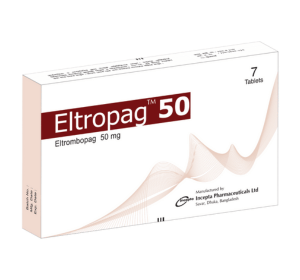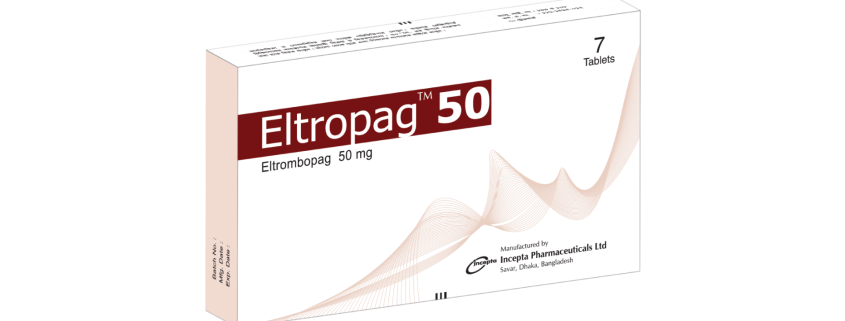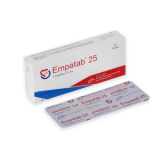Eltropag(Eltrombopag)
Therapeutic Group: Haemostatic Drug

Presentation
EltropagTM 25: Each film coated tablet contains Eltrombopag Olamine INN equivalent to Eltrombopag 25 mg.
EltropagTM 50: Each film coated tablet contains Eltrombopag Olamine INN equivalent to Eltrombopag 50 mg.
Description
Eltrombopag is an orally bioavailable, small-molecule TPO-receptor agonist that interacts with the transmembrane domain of the human TPO-receptor and initiates signaling cascades that induce proliferation and differentiation from bone marrow progenitor cells.
Indications
Eltrombopag is indicated for: Thrombocytopenia in adult and pediatric patients 1 year and older with chronic immune. (idiopathic) thrombocytopenia (ITP) who have had an insufficient response to corticosteroids, immunoglobulins, or splenectomy. Thrombocytopenia in patients with chronic hepatitis-C to allow the initiation and maintenance of interferon-based therapy. Patients with severe aplastic anemia who have had an insufficient response to immunosuppressive therapy.
Dosage & Administration
Take on an empty stomach (1 hour before or 2 hours after a meal).Chronic ITP: Initial dose of Eltrombopag for most of the adult and pediatric patients of 6 years. & older is 50 mg once daily. For pediatric patients aged from 1 to 5 years the initial dose. should be 25 mg once daily. Adjust to maintain platelet count greater than or equal to 50 x 109/L.
Do not exceed 75 mg per day. Chronic Hepatitis C-associated Thrombocytopenia: Initiate Eltrombopag at 25 mg once daily for all patients. Adjust to achieve target platelet count required to initiate antiviral therapy. Do not exceed a daily dose of 100 mg. Severe Aplastic Anemia: Initiate Eltrombopag at 50 mg once daily for most patients. Adjust to maintain platelet count greater than or equal to 50 x 109/L. Do not exceed 150 mg per day.
Side Effects
In adult patients with ITP, the most common adverse reactions were: Nausea, diarrhea, upper respiratory tract infection, vomiting, increased ALT, myalgia, and urinary tract infection etc.The most common adverse drug reactions seen in children of 1 year and older is upper respiratory tract infections and nasopharyngitis. Patients with chronic hepatitis C associated thrombocytopenia: Anemia, pyrexia, fatigue, headache, nausea, diarrhea, alopecia and peripheral edema is very common. Patents with severe aplastic anemia: The most common adverse effect is nausea, fatigue, cough, diarrhea, headache etc.
Precautions
Hepatotoxicity: In this case, monitor liver function before and during therapy. Thromboembolic complication: Portal vein thrombosis has been reported in patients with chronic liver disease receiving Eltrombopag, so platelet count should be measured carefully.
Use in Pregnancy & Lactation
Pregnancy: Pregnancy Category C. Nursing mothers: It is not known whether eltrombopag is excreted in human milk. A decision should be made whether to discontinue nursing or to discontinue eltrombopag taking into account the importance of eltrombopag to the mother.
Drug Interaction
Eltrombopag interacts with polyvalent cation-containing Antacids. .Caution should be taken when administered with OATP1B1 substrate and BCRP substrate (Rosuvastatin), Protease inhibitors (Iopinavir) etc.
Over Dose
In case of an overdose, consider oral administration of a metal cation-containing preparation, such as calcium, aluminum, or magnesium preparations to chelate eltrombopag and thus limit absorption. Closely monitor platelet counts.
Storage
Do not store above 30 C. Keep away from light and out of the reach of children.
Commercial Pack
Eltropag 25: Each box contains 1 blister strip of 10 tablets.
Eltropag 50: Each box contains 1 blister strip of 7 tablets.
Others
The safety and efficacy of eltrombopag in pediatric patients younger than 1 year with ITP and thrombocytopenia associated with chronic hepatitis C & severe aplastic anemia have not been established.



